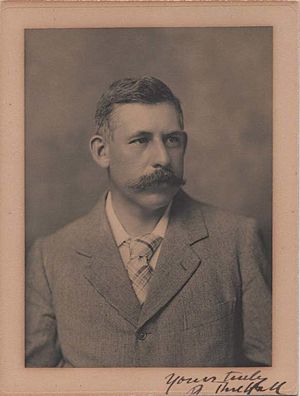Richard Threlfall facts for kids
Sir Richard Threlfall (born August 14, 1861 – died July 10, 1932) was an amazing English scientist and engineer. He helped start the School of Physics at the University of Sydney in Australia. He also made very important contributions to military science during World War I. Because of his great work, he became a special member of the Royal Society in 1899. He also received high honors, becoming a Knight Commander of the Order of the British Empire (KBE) in 1917 and a Knight Grand Cross (GBE) in 1927.
Contents
Early Life and School Days
Richard Threlfall was born near Preston, Lancashire, England. He went to Clifton College, where he was a great student and athlete. He was even the captain of the rugby team and good at rifle shooting.
After Clifton, he went to Gonville and Caius College, Cambridge University. There, he continued to play rugby and shoot rifles for his university. He was also a talented speaker and got excellent grades in science, especially in physics and chemistry. He married Evelyn Agnes, who was one of four sisters who all married important men.
His Science Journey
After finishing university, Richard Threlfall worked at the Cavendish laboratory. He did a lot of original research and was a good teacher. He also studied at Strasburg University in Germany.
He had an accident while working with a chemical called nitroglycerine, which caused him to lose some of his fingers. But even with this injury, he continued to be very skilled with his hands in the lab.
Becoming a Professor
In 1886, Threlfall was chosen to be a physics professor at the University of Sydney. He had to start the physics school from almost nothing! When he began, there was no building and very little equipment.
But by 1888, a new physics laboratory was finished, and all the necessary tools were bought. He worked very hard and also found time for his own research. One of his early inventions was the "rocking microtome". This is a special tool that helps cut very thin slices of material, which was super helpful for studying biology.
Another invention was a "quartz thread balance". This allowed him to measure gravity at different places with amazing accuracy. In 1896, he led a special group looking into how coal was carried on ships. He left his job at the University of Sydney at the end of 1898 because he needed to live back in England.
Working as an Engineer
After returning to England, Threlfall became a consulting engineer. He became very well-known for his skills in electro-chemistry, which combines chemistry and engineering. He joined a company called Albright and Wilson, which made a lot of phosphorus. He worked with them until he passed away.
His experience with this company was incredibly helpful to his country during the 1914–18 war. He especially helped with things like smoke screens (to hide things) and tracer bullets (bullets that glow so you can see where they go).
During the war, he joined many important groups. In 1915, he was on the Board of Invention and Research. In 1916, he joined the advisory council for scientific and industrial research and also the munitions inventions board. He became a member of the chemical warfare committee in 1917. In 1918, he joined the food preservation board. He also joined the fuel research board in 1917, which continued its work after the war, and he became its chairman in 1923.
Even though his main work was in industrial chemistry, he always stayed interested in pure science. He often went to meetings of the Royal Society of London.
Later Life and Legacy
Sir Richard Threlfall passed away on July 10, 1932. He is buried in a family tomb at St Anne's Church in Woodplumpton, Lancashire. He had four sons and two daughters. He also wrote a book called On Laboratory Arts in 1898 and many papers for science magazines.


